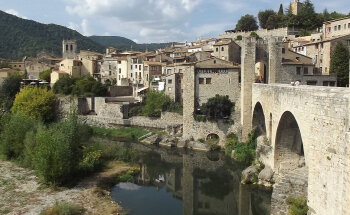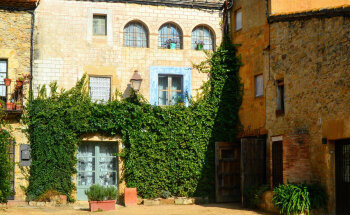La Bisbal d'Empordà

The capital of the Baix Empordà is especially renowned for its ceramic craftsmanship: a very important activity for the town, which gives life to its streets and has been present since the 18th century.
"Ceràmica de la Bisbal" is the registered trademark that will allow you to recognize the town's own products and you can find them in the specialized shops, in the Terracotta Museum and even in the workshop of some potters.
But the charm of La Bisbal d'Empordà is also in its surroundings.
There are several routes for all levels that will allow you to get to know the town in a different way: you can visit Els Pous del Glaç d'en Salamó, el Daró and la Font de l'Arbre or even go to Castell d'Empordà and see its medieval centre. We recommend you 100% the views from the Castell-Palau de la Bisbal, they are spectacular!
And, if cycling is your thing, there are also routes of varying difficulty that are ideal for this sport.
If you have the opportunity, we recommend you visit the town during the Fira del Circ al Carrer de la Bisbal d'Empordà, a traditional festival in which a wide variety of circus artists take part in different shows.
Monells

Monells is one of the nuclei of the municipality of Cruïlles, Monells and Sant Sadurní de l'Heura.
Monells has a special charm because it is built around the remains of a castle, of which only the walls have been preserved. Its streets still preserve their medieval essence and walking through them is a journey into the past. Come to the arcaded square: it is the ideal place for your medieval postcards.
The Rissec stream divides the town in two and the landscape from its bridges is magnificent. Monells, although small, is extraordinarily photogenic and has a lot of charm.
And a cinematic curiosity: Monells was one of the main scenes in "Eight Catalan Surnames", the sequel to the successful "Eight Basque Surnames".
Peratallada

Peratallada is a town with a great historical heritage and has been declared a Historical-Cultural Site and a Cultural Asset of National Interest because of its medieval architecture. Its appearance seems immune to the passage of time.
To enter the municipality, you must leave your car in one of its car parks outside the walls. When you enter through one of its gates, you will be greeted by its narrow, labyrinthine streets that end in a small square full of restaurants and small craft shops.
As you can imagine, a medieval festival is a must in a town like this. At the medieval fair of Peratallada, the whole town becomes the stage for medieval shows and they recreate a medieval market of artisan products.
Pals

Pals is one of the jewels of the Baix Empordà and, possibly, of all Catalonia.
Its architecture is exceptionally well preserved. As if time had frozen over for its streets and stone facades, arches and towers.
We recommend that you visit the wall, with its four towers of the fourth century, and considered the viewpoint of the Costa Brava. The Torre de las Horas is what remains of the castle that was built during the Catalan Civil War in the 15th century and later converted into the bell tower that gives it its name.
For wine tourism lovers, you should know that in Pals you will find the Ca La Pruna Culture Museum-House, with an exhibition of Catalan wines and cavas and a replica of an 18th century pharmacy.
And don't miss a visit to the rice fields with the "Xiulet de Pals" train. An hour and a half visit around the fields that includes a visit to the mill of Arròs de Pals, a gastronomic emblem!
And remember, in the words of Josep Pla: "Pals is not good for one, but for hundreds of visits".
Palau-Sator

Palau-Sator is a municipality with several urban centres (Palau-Sator, Fontclara, Sant Julià de Boada, Sant Feliu de Boada i Pantaleu) and an excellent location within the region.
Its great tourist attraction is the 12th century wall, which is very well preserved and can be crossed through a gateway to the old town.
In each of the towns you will find a church with a peculiar history. If you have time, come and visit them and learn more about their history .
In addition, in the centre of the village there is the castle: a fortification from the 10th century declared to be of national interest, of which the twenty-metre high Torre de las Horas is still preserved.
And, foodies, rejoice. Here you will find the Mas Pou restaurant, one of the best restaurants in the region. A visit is a must.
La Pera

La Pera is a municipality located in the west of the Baix Empordà region and is also made up of several towns: Púbol, Pedrinyà and Riuràs.
Among the medieval streets of La Pera, you can discover such beautiful corners as the Pont del Tinell.
In Púbol, the place where Salvador Dalí died and where his wife Gala is buried, is the Gala Dalí Castle Museum-House. One of the key points of Catalan surrealism.
A visit to the Church of Sant Pere (14th century) is also a must. Despite the fact that most of its treasures were destroyed during the Civil War, they managed to rescue the 15th century work of Bernat Martorell, which is currently on display at the Girona Art Museum.
Ullastret

The home of the Iberian City of Ullastret: the largest Iberian city in Catalonia.
The visit to this ancient city is complemented by its Museum, which displays the archaeological discoveries of the site: the Cutting Hammer, the Terracotta masks, the Glass of Horses and several pieces from the 6th century BC.
Another place worth visiting is the Romanesque church of Sant Pere d'Ullastret, from the 11th century.
Ullastret was a totally walled medieval town and it was not until the 15th century that the population expanded outside its walls. If you walk through its narrow and steep streets you will discover parts of the old wall in a very good state of preservation. Today, ten towers of the wall have been preserved: one of them, the prison, will be easy to distinguish by its circular shape.
If you visit Ullastret, take the opportunity to have a drink on its terraces: they have an unbeatable view!
Torroella de Montgrí

Torroella de Montgrí is a village surrounded by fields and orchards where agriculture plays a very important role.
So is its Montgrí Castle, visible from many parts of the Empordà. The route to the Castle can be done on foot and is suitable for doing the route with the children of the house (although not with prams).
We can also find the Museum of the Mediterrània, dedicated to the knowledge of the Mediterranean Sea through sound and music, with art spaces and permanent and temporary exhibitions.
Torroella de Montgrí is the ideal place to walk and disconnect from our routine. Throughout your walk, you will discover the variety of periods that have shaped the municipality.
A visit to the Plaza de la Vila is a must, a porticoed square full of places of leisure where you will find the Town Hall and the Chapel of Sant Antoni.
And if you like popular legends, come to the Witches' Tower. It was a regular meeting place for witches and horses, terrified, refused to cross its portal. The king had it walled up, but the next day, it was punctured. And again. And again. When the king decided to put up a guard, the guards disappeared in the night. Since then, visiting the site on Saturday nights is no longer recommended. You yourselves...
Palamós

Palamós is synonymous with the aroma of the sea, fishing, beaches and breezes. A place full of history with origins in the time of piracy.
One of the most important places is its port, which became a strategic place for expansion and the fight for the Mediterranean. Visit the Fishing Museum, the Fish Market and the Market but, above all, the Fish Space: a gastronomic classroom where we can learn to identify fish, prepare it and cook it through courses, workshops and tastings.
Another place full of charm is the Camino de Ronda. It is the perfect place to get to know the coastal path. You will pass by Cala S'Alguer, considered a Cultural Asset of National Interest for its landscapes. Imagine what they are like!
Playa del Castell is pure Mediterranean landscape. And, if you follow the Camino de Ronda, you will also discover the Iberian Village of Castell, where there are archaeological remains of an Iberian site, the Castle of Vila-Romà and the Sanctuary of Bell-Lloc.
To round off your visit to Palamós, don't miss some of the viewpoints that are scattered throughout the town: the Plaza Murada, the natural viewpoint of the port, the Punta del Muelle Nuevo, the Pedró, the Windmill ... a delight for your eyes (and your cameras).
Begur

Begur is one of the most charming villages on the Costa Brava. Its monuments, the Romanesque centre of Esclanyà, its coves and beaches, Begur gives shape to a wonderful landscape.
Its history lies mainly in the famous Begur Castle. A great architectural or medieval piece that stands out from any corner of the town and one of the places that should appear on a postcard of Begur.
Begur is very famous for its beaches and coves with transparent water that invites you to swim. Walk the Camino de Ronda and you will discover spectacular corners between the different beaches. Tranquility and landscape in equal parts.
You will also be able to enjoy its hiking routes (the Water Way, the Local Path Des Quinze...) of different levels and durations.
The gastronomy of Begur reflects the richness of the city, focused on fish and seafood. Rock fish is the main gastronomic element of Begur and every year they celebrate a gastronomic campaign in which the restaurants prepare their best dishes - a magnificent opportunity to discover the gastronomy of the Costa Brava!












